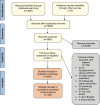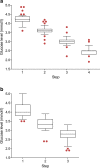Hyperinsulinaemic-hypoglycaemic glucose clamps in human research: a systematic review of the literature
- PMID: 33566134
- PMCID: PMC7940281
- DOI: 10.1007/s00125-020-05361-8
Hyperinsulinaemic-hypoglycaemic glucose clamps in human research: a systematic review of the literature
Abstract
Aims/hypothesis: The hyperinsulinaemic-hypoglycaemic glucose clamp technique has been developed and applied to assess effects of and responses to hypoglycaemia under standardised conditions. However, the degree to which the methodology of clamp studies is standardised is unclear. This systematic review examines how hyperinsulinaemic-hypoglycaemic clamps have been performed and elucidates potential important differences.
Methods: A literature search in PubMed and EMBASE was conducted. Articles in English published between 1980 and 2018, involving adults with or without diabetes, were included.
Results: A total of 383 articles were included. There was considerable variation in essential methodology of the hypoglycaemic clamp procedures, including the insulin dose used (49-fold difference between the lowest and the highest rate), the number of hypoglycaemic steps (range 1-6), the hypoglycaemic nadirs (range 2.0-4.3 mmol/l) and the duration (ranging from 5 to 660 min). Twenty-seven per cent of the articles reported whole blood glucose levels, most venous levels. In 70.8% of the studies, a dorsal hand vein was used for blood sampling, with some form of hand warming to arterialise venous blood in 78.8% of these. Key information was missing in 61.9% of the articles.
Conclusions/interpretation: Although the hyperinsulinaemic-hypoglycaemic clamp procedure is considered the gold standard to study experimental hypoglycaemia, a uniform standard with key elements on how to perform these experiments is lacking. Methodological differences should be considered when comparing results between hypoglycaemic clamp studies.
Prospero registration: This systematic review is registered in PROSPERO (CRD42019120083).
Keywords: Diabetes; Diabetes mellitus; Human; Hyperinsulinaemic–hypoglycaemic clamp; Hypoglycaemia; Systematic review; Type 1 diabetes; Type 2 diabetes.
Figures



References
-
- DeFronzo RA, Tobin JD, Andres R. Glucose clamp technique: a method for quantifying insulin secretion and resistance. Am J Physiol Metab. 1979;237(3):E214. - PubMed
Publication types
MeSH terms
Substances
LinkOut - more resources
Full Text Sources
Other Literature Sources
Medical

